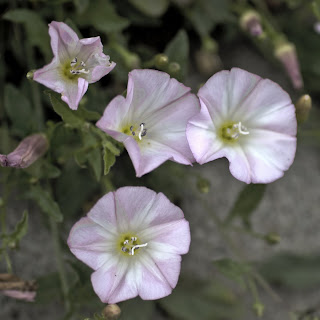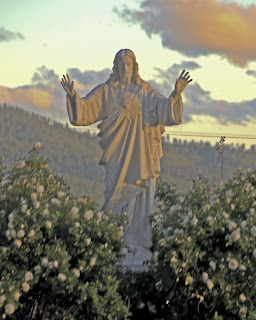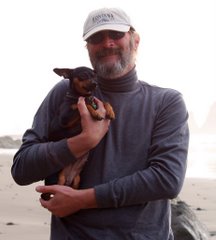 Study in Orange
Study in Orange(A poppy growing in my next door neighbor's front yard)
One of my first efforts at HDR Imaging
Taken 6/20/09 in Missoula, Montana
NOTE: Clicking on any picture, or on any link, will open a new window without closing the current window, and show the pictures full screen or larger (depending on your screen). I really recommend viewing the photos full screen so you can get a better idea of just what HDR imaging can do.
WARNING: The text here is probably of interest only to those people who are having fun playing with digital photography. Feel free to view the pictures and skip the text. Or skip it all, how will I know?
Kodachrome
They give us those nice bright colors
They give us the greens of summers
Makes you think all the world's a sunny day, Oh yeah
I got a Nikon camera
I love to take a photograph
So mama don't take my Kodachrome away
--Paul Simon
They give us those nice bright colors
They give us the greens of summers
Makes you think all the world's a sunny day, Oh yeah
I got a Nikon camera
I love to take a photograph
So mama don't take my Kodachrome away
--Paul Simon
To hear Paul Simon sing Kodachrome on YouTube, click here!
Forget Mama, Kodak is taking Kodachrome away. Apparently there is only one place left in the country that actually processes Kodachrome. But that is beside the point. Can't remember the last time I actually bought Kodachrome, or Ektachrome for that matter. For a brief while after I bought the Nikon Coolpix for my birthday in October 2006, I continued to use my Pentax 35mm SLR, but once I got the D80, I went completely digital and haven't looked back. Apparently I'm not alone in that. Even for Kodak, 70% of their current business is digital.
And digital photography is amazing. The things you can do with those bits and pieces known as pixels once they're cavorting in your computer. With Kevin on the road, and my evenings now free for me to do whatever I choose, I chose to start improving my digital photography skills. First off, I started looking back through the past three years of pictures I've taken with my great Nikon D80, and it was sobering to find that the pictures I took three years ago look much better than the ones I'm taking now. Have I gotten lazy? complacent? Whatever, it's not a good thing to regress in one's skill set. SO....
I now have available to me Adobe's Creative Suite 4 with a whole range of great programs, including Photoshop CS4. Up until now, I've used Photoshop Elements for all my editing work, and it has served me well. I'm told that anything you can do in Photoshop, you can do in Elements, but you'll have to work twice as hard. Then again, learning how to use Photoshop involves a lot of time and effort, but I think it will be worth it.
Recently I followed the lead of a couple of on-line photographer friends and joined Red Bubble as a way to offer my photography for sale on-line. As with many other on-line social networks, Red Bubble has a variety of groups you can join. One I joined is for those who photograph wildflowers. Among the stated criteria for this group, I found the following: No photoshopping or HDR work will be accepted. OK, I can agree to this--except I have no idea what HDR means.
 Good Morning, Glory
Good Morning, Glory
Weeds growing by my mailbox
Another early HDR effort
Taken 6/20/09 in Missoula, Montana
As it turns out, HDR is the abbreviation for High Dynamic Range. (The link will take you to the Wikipedia article on HDR Imaging.) I can't speak for you, but I'm of the generation that never accepted being told what we could not do. I had to find out just what HDR is and how I could play with it. Scott Kelby, the author of one of my Photoshop CS4 manuals, was just the man to tell me what and how. In fact, he has a whole chapter devoted to HDR in his Adobe Photoshop CS4 Book for Digital Photographers (Voices That Matter). Yes, that's the whole title of the book.
I followed his instructions scrupulously to produce four of the five images shared in this post, but first I had to go to my Nikon D80 manual and learn one more thing to do with my camera. Bracketing. Now I have always known what bracketing is. My dad used to bracket his pictures on a regular basis. What I didn't know was how to do it automatically with my Nikon. Now I know. (If you don't understand bracketing, it means that you take the same picture using different exposures, usually one you would consider standard, then one that is over exposed and one that is under exposed.)
So, once you have three to five bracketed shots, Photoshop allows you to merge all the images into one, in essence bringing out the details that would normally be washed out or hidden in the shadows. For the first time since I bought it, I found a reason to have a professional level Nikon instead of my one-step away from professional D80. The professional level cameras allow for 5 shots when automatically bracketing. My D80 only allows for 3. Still, given the length of time it takes Photoshop to merge three shots, I hate to think what it would take to do 5. I won't go into the numbers involved, but suffice it to say that even using 3 shots, the resultant image has more detail than standard computer monitors (or even paper should you print the image out) can handle. An HDR image starts as 32-bit or even 48-bit (whatever that means), as compared to a J-PEG image which is 8-bit. Whatever it means, it's a lot of information for your computer to handle. Once Photoshop has merged the various images into one, you can then edit that one in either Camera Raw or through the regular editing processes.
 Statue of Christ in St Mary's Cemetery Annex
Statue of Christ in St Mary's Cemetery Annex
(I'm not happy with this image, but share it as an example of how 3-dimensional the statue becomes in HDR)
Taken 6/21/08 in Missoula Montana
After taking several macro shots of flowers and merging them into HDR images, I decided to see what would happen with larger scenes. Driving out behind our home to climb the hill and get a view of the valley, I passed the St Mary's Cemetery Annex. The sun was positioned exactly right to really light up the statue of Christ. What a subject, I said to myself, and got out of the car. By the time I got the camera on the tripod, and the tripod set in position--and most importantly by the time I realized that the camera was no longer set to automatically bracket shots, the sun had moved off the Son. So as I noted above, I'm not very happy with the final result, but it does provide an example of how isolated features, such as the statue, become almost 3-dimensional in HDR images.
Now all this supposes that you are getting exactly the same scene in each of your bracketed shots. My D80 can shoot 3 frames per second, but it's amazing what can happen in that short amount of time. I know from experience now that if you're shooting a flower that is blowing in the wind, you'll end up with a very strange, almost abstract design. Nor am I completely convinced that HDR is the way to go--at least not yet. The image that Kelby uses in his instructions is an urban landscape. With that in mind, I drove up WaterWorks Hill north of town to shoot some scenes looking over the Missoula Valley. I was careful to use the tripod and make sure the camera did not move while shooting the three bracketed images. I then processed the three as an HDR image and also processed just the standard exposure as a regular J-PEG image. I am posting both here so you can make up your mind. The flowers, I thought, were superb. The landscape, well, I'm not sure it's worth the effort. The main difference that I can see is that the clear sky is washed out in the J-PEG, but still shows blue in the HDR thanks to using the extra exposures. The overall coloring is lighter in the HDR, again because of the extra exposures, but which final product is better--well that's a judgement call. I will keep trying, experimenting, honing my skills. After all, with Kevin on the road, I do have all this time on my hands.
Forget Mama, Kodak is taking Kodachrome away. Apparently there is only one place left in the country that actually processes Kodachrome. But that is beside the point. Can't remember the last time I actually bought Kodachrome, or Ektachrome for that matter. For a brief while after I bought the Nikon Coolpix for my birthday in October 2006, I continued to use my Pentax 35mm SLR, but once I got the D80, I went completely digital and haven't looked back. Apparently I'm not alone in that. Even for Kodak, 70% of their current business is digital.
And digital photography is amazing. The things you can do with those bits and pieces known as pixels once they're cavorting in your computer. With Kevin on the road, and my evenings now free for me to do whatever I choose, I chose to start improving my digital photography skills. First off, I started looking back through the past three years of pictures I've taken with my great Nikon D80, and it was sobering to find that the pictures I took three years ago look much better than the ones I'm taking now. Have I gotten lazy? complacent? Whatever, it's not a good thing to regress in one's skill set. SO....
I now have available to me Adobe's Creative Suite 4 with a whole range of great programs, including Photoshop CS4. Up until now, I've used Photoshop Elements for all my editing work, and it has served me well. I'm told that anything you can do in Photoshop, you can do in Elements, but you'll have to work twice as hard. Then again, learning how to use Photoshop involves a lot of time and effort, but I think it will be worth it.
Recently I followed the lead of a couple of on-line photographer friends and joined Red Bubble as a way to offer my photography for sale on-line. As with many other on-line social networks, Red Bubble has a variety of groups you can join. One I joined is for those who photograph wildflowers. Among the stated criteria for this group, I found the following: No photoshopping or HDR work will be accepted. OK, I can agree to this--except I have no idea what HDR means.
 Good Morning, Glory
Good Morning, GloryWeeds growing by my mailbox
Another early HDR effort
Taken 6/20/09 in Missoula, Montana
As it turns out, HDR is the abbreviation for High Dynamic Range. (The link will take you to the Wikipedia article on HDR Imaging.) I can't speak for you, but I'm of the generation that never accepted being told what we could not do. I had to find out just what HDR is and how I could play with it. Scott Kelby, the author of one of my Photoshop CS4 manuals, was just the man to tell me what and how. In fact, he has a whole chapter devoted to HDR in his Adobe Photoshop CS4 Book for Digital Photographers (Voices That Matter). Yes, that's the whole title of the book.
I followed his instructions scrupulously to produce four of the five images shared in this post, but first I had to go to my Nikon D80 manual and learn one more thing to do with my camera. Bracketing. Now I have always known what bracketing is. My dad used to bracket his pictures on a regular basis. What I didn't know was how to do it automatically with my Nikon. Now I know. (If you don't understand bracketing, it means that you take the same picture using different exposures, usually one you would consider standard, then one that is over exposed and one that is under exposed.)
So, once you have three to five bracketed shots, Photoshop allows you to merge all the images into one, in essence bringing out the details that would normally be washed out or hidden in the shadows. For the first time since I bought it, I found a reason to have a professional level Nikon instead of my one-step away from professional D80. The professional level cameras allow for 5 shots when automatically bracketing. My D80 only allows for 3. Still, given the length of time it takes Photoshop to merge three shots, I hate to think what it would take to do 5. I won't go into the numbers involved, but suffice it to say that even using 3 shots, the resultant image has more detail than standard computer monitors (or even paper should you print the image out) can handle. An HDR image starts as 32-bit or even 48-bit (whatever that means), as compared to a J-PEG image which is 8-bit. Whatever it means, it's a lot of information for your computer to handle. Once Photoshop has merged the various images into one, you can then edit that one in either Camera Raw or through the regular editing processes.
 Statue of Christ in St Mary's Cemetery Annex
Statue of Christ in St Mary's Cemetery Annex(I'm not happy with this image, but share it as an example of how 3-dimensional the statue becomes in HDR)
Taken 6/21/08 in Missoula Montana
After taking several macro shots of flowers and merging them into HDR images, I decided to see what would happen with larger scenes. Driving out behind our home to climb the hill and get a view of the valley, I passed the St Mary's Cemetery Annex. The sun was positioned exactly right to really light up the statue of Christ. What a subject, I said to myself, and got out of the car. By the time I got the camera on the tripod, and the tripod set in position--and most importantly by the time I realized that the camera was no longer set to automatically bracket shots, the sun had moved off the Son. So as I noted above, I'm not very happy with the final result, but it does provide an example of how isolated features, such as the statue, become almost 3-dimensional in HDR images.
Now all this supposes that you are getting exactly the same scene in each of your bracketed shots. My D80 can shoot 3 frames per second, but it's amazing what can happen in that short amount of time. I know from experience now that if you're shooting a flower that is blowing in the wind, you'll end up with a very strange, almost abstract design. Nor am I completely convinced that HDR is the way to go--at least not yet. The image that Kelby uses in his instructions is an urban landscape. With that in mind, I drove up WaterWorks Hill north of town to shoot some scenes looking over the Missoula Valley. I was careful to use the tripod and make sure the camera did not move while shooting the three bracketed images. I then processed the three as an HDR image and also processed just the standard exposure as a regular J-PEG image. I am posting both here so you can make up your mind. The flowers, I thought, were superb. The landscape, well, I'm not sure it's worth the effort. The main difference that I can see is that the clear sky is washed out in the J-PEG, but still shows blue in the HDR thanks to using the extra exposures. The overall coloring is lighter in the HDR, again because of the extra exposures, but which final product is better--well that's a judgement call. I will keep trying, experimenting, honing my skills. After all, with Kevin on the road, I do have all this time on my hands.





























